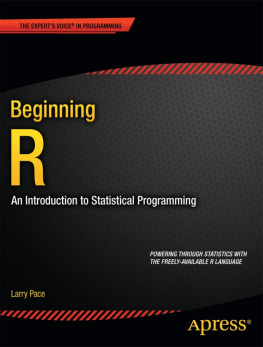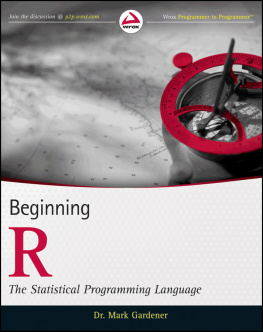Copyright 2010 by SAGE Publications, Inc.
All rights reserved. No part of this book may be reproduced or utilized in any form or by any means, electronic or mechanical, including photocopying, recording, or by any information storage and retrieval system, without permission in writing from the publisher.
For information:
 | SAGE Publications, Inc. 2455 Teller Road Thousand Oaks, California 91320 E-mail: | SAGE Publications India Pvt. Ltd. B 1/I 1 Mohan Cooperative Industrial Area Mathura Road, New Delhi 110 044 India |
SAGE Publications Ltd. 1 Olivers Yard 55 City Road London EC1Y 1SP United Kingdom | SAGE Publications Asia-Pacific Pte. Ltd. 33 Pekin Street #0201 Far East Square Singapore 048763 |
Printed in the United States of America
Library of Congress Cataloging-in-Publication Data
Hogan, Thomas P.
Bare-bones R: a brief introductory guide / Thomas P. Hogan.
p. cm.
Includes bibliographical references and index.
ISBN 9781-41298041-8 (pbk.)
1. Social sciencesStatistical methodsData processing. 2. StatisticsData processing. 3. R
(Computer program language) I. Title.
HA32.H64 2011
005.262dc22 2009033530
This book is printed on acid-free paper.
09 10 11 12 13 10 9 8 7 6 5 4 3 2 1
Acquisitions Editor: | Vicki Knight |
Associate Editor: | Lauren Habib |
Editorial Assistant: | Ashley Dodd |
Production Editor: | Carla Freeman |
Copy Editor: | QuADS Prepress (P) Ltd. |
Typesetter: | C&M Digitals (P) Ltd. |
Proofreader: | Christina West |
Cover Designer: | Stephanie Adams |
Marketing Manager: | Gail Buschman |
Preface
I intend this bare-bones introduction to R as a supplement to a standard first-course textbook in statistics or for those who have already completed such a course and now need to do some statistical analysis on their own. This introduction, as suggested by its title, is bare-bones. It doesnt pretend to teach everything about Rjust to get people started with it.
R is a wonderful tool for statistical work. Its flexibility and richness offer a boon to experienced researchers. It also offers great advantages for statistical novicesthose taking their first course in statistics. However, for such novices, R can be intimidating, precisely because of its flexibility and richness. Its arcane customs, symbols, and terminology may make the novice shudder. Some of the purported introductions to R seem like trying to teach Mozart concertos in the first week of piano lessons. They are just overwhelming. In my experience, extant introductions share the following drawbacks, not for the experienced researcher but for the novice. They tend to present several ways of accomplishing any given task (thus nicely illustrating Rs richness), whereas the novice needs just one way to do it. They tend to use traditional R terminology (arguments of functions, vectors, etc.) rather than plain English. They are very short on examples. This feature helps their compactness, but novices need examples. They tend to include advanced statistical techniques (logistic regression, mixed-effects ANOVA, etc.), while the novice is still trying to learn the difference between a mean and a median. I have tried to avoid these drawbacks.
I make the following assumptions about the students using this bare-bones introduction:
- I assume that they are taking a first course in statistics or have already completed such a course. Im not trying to teach statistical concepts and techniques such as mean, standard deviation, correlation coefficient, t test, and analysis of variance. I assume that the statistics instructor and textbook will cover these topics.
- I assume that they have experience with personal computers, the Internet, and a word processing system.
- I assume that they (and their instructors) can devote a very limited amount of time to this bare-bones introduction. Id like to think one could get through this entire introduction, including working through the examples, in a few hours.
- I do not assume that they have had any prior experience in computer programming.
- Finally, Im going to use the Windows platform. Its the most commonly available. R will work on other platforms, and much of what we cover here will work perfectly well on other platforms, but to keep things simple, Im just using Windows.
Here are the guidelines I used in putting this material together:
- Start from the very beginning with each topic. This includes downloading R, R Commander, and an add-on package.
- Keep it short. Dont try to cover everythingjust get started.
- Always include at least one example for anything that gets introduced.
- When there are several different ways to accomplish something, just present one, and move on.
- When its necessary to introduce some of Rs weird terms, try to give a translation into plain English or, at least, into the common language of elementary statistics.
- Use examples from the behavioral/social sciences. A lot of what we cover will work equally well in other fields, for example, biology, allied health fields, and business, but Ive not tried to include examples from these other fields.
- Dont introduce any statistical techniques beyond those covered in the typical first course in statistics in the behavioral/social sciences. In fact, dont even try to cover all the techniques in the first course. A sampling of them will do.
- Use textboxes, highlighting, varying fonts, and so on to enhance students comprehension.
- Introduce both base R (and its usual add-on packages) and R Commander. As tempting as it is, I dont think doing R Commander by itself (or even first) is a good idea.
Occasionally, I must admit, I violate one of these rulesbut only occasionally.
I realize that my assumptions and rules, as just outlined, may encourage my colleagues to pummel me with criticisms. Why introduce only this way to accomplish some task? What about this nifty add-on package? Wont this common English translation of a technical R term possibly mislead? And so on. Ill accept those criticisms. But Ill add a bet. If, within a few hours of instruction, I can get students feeling comfortable and confident using R, Ill bet those students will go on to learn a whole lot more about R on their own. We just need a good start.


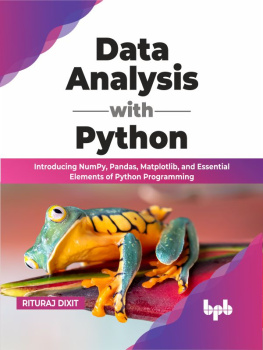
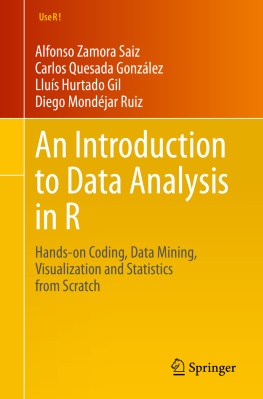
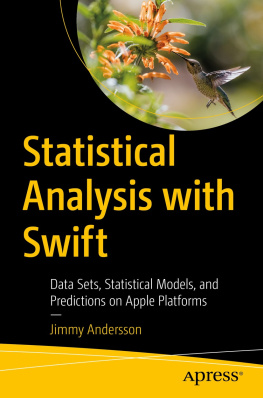
![James D. Miller [James D. Miller] - Statistics for Data Science](/uploads/posts/book/119637/thumbs/james-d-miller-james-d-miller-statistics-for.jpg)
![Thomas Mailund [Thomas Mailund] - Beginning Data Science in R: Data Analysis, Visualization, and Modelling for the Data Scientist](/uploads/posts/book/119629/thumbs/thomas-mailund-thomas-mailund-beginning-data.jpg)

